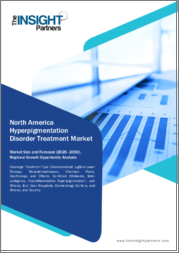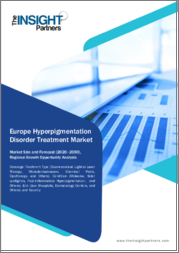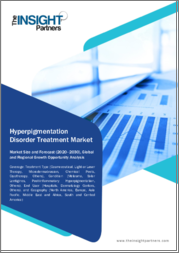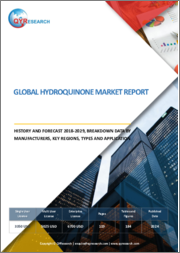
|
시장보고서
상품코드
1597094
북미의 색소침착증 치료 시장 예측 : 지역별 분석-치료 유형별, 증상별, 최종 사용자별(-2030년)North America Hyperpigmentation Disorder Treatment Market Forecast to 2030 - Regional Analysis - by Treatment Type, Condition, and End User |
||||||
북미의 색소침착증 치료 시장은 2022년에 16억 9,483만 달러로 평가되었고, 2030년까지는 30억 2,873만 달러에 이를 것으로 예측되며, 2022년부터 2030년까지 CAGR은 7.5%로 추정됩니다.
간반의 유병률 상승이 북미의 색소침착증 치료 시장을 견인
가장 지배적인 색소침착증 중 하나인 간반은 얼굴, 특히 턱, 윗입술, 코, 이마 및 뺨에 경계가 있는 좌우 대칭의 옅은 색에서 어두운 갈색 반점이 특징입니다. 여성 및 피부색이 검은 사람들에게 많습니다. 간반에서는 입술, 하악 및 안면 중앙부의 임상 특징이 일반적입니다. 햇빛 노출, 호르몬 변동, 임신, 유전적 요인, 화장품 및 의약품은 모두 간반의 발생과 관련이 있습니다. 다양한 연구를 통해 일반 인구에서 간반의 전체 유병률은 1%에서 50%로 추정됩니다. 간반 사례의 55%에서 64%가 같은 증상의 가족력을 보고합니다. 또한 동아시아계 및 히스패닉계 사람들뿐만 아니라 피츠패트릭 피부의 포토유형이 높은 환자(IV-VI)에서 더 높은 유병률이 보고되었습니다.
임신도 간반의 일반적인 원인입니다. 이 증상은 경구 피임약과 호르몬제를 복용하는 여성에게도 영향을 미칩니다. 에스트로겐, 프로게스테론, 멜라닌세포 자극 호르몬의 농도는 일반적으로 임신 중기에 상승하기 때문에 그 영향도 고려됩니다. 2023년 8월 미국립생물공학정보센터(NCBI)에 따르면 간반은 생식기에 많으며 사춘기 전에 발생하는 경우는 드뭅니다. 이 증상은 임산부의 15%에서 50%로 나타나며, 그 유병률은 지역에 따라 1.5%에서 33%입니다. 따라서 간반의 유병률 증가가 색소침착증 치료에 대한 수요의 방아쇠가 되고 있습니다.
북미의 색소침착증 치료 시장 개요
북미의 색소침착증 치료 시장은 미국, 캐나다, 멕시코로 구분됩니다. 2023년 북미의 색소침착증 치료 시장 점유율은 미국이 최대입니다. Skin of Color Update 2024(피부과학회)에 따르면 미국의 인구동태는 히스패닉계, 아시아계, 아프리카계의 국제 이주에 의한 민족 및 인종적 다양성의 확대와 함께 진화하고 있으며, 2050년경에는 피츠패트릭 III, IV, V, VI 피부 유형의 마이너리티가 주류가 될 가능성이 높습니다. 특히 히스패닉계 인구는 미국에서 가장 빠르게 성장하는 인구 집단 중 하나이며, 2014년 5,500만 명에서 2060년에는 1억 1,900만 명으로 증가할 것으로 추정됩니다. 흑색 피부 유형은 색소 침착 장애를 일으키기 쉽습니다.
미국에서의 미용 성형 수술 건수는 지난 10년간 크게 증가하고 있습니다. 국제성형외과학회(ISAPS)에 따르면 2021년 비외과적 미용 시술 건수는 전 세계적으로 2020년 대비 19.9% 증가했습니다. 인텐스 펄스 라이트(IPL) 치료는 저침습성 미용 수술의 톱 5에 속하며, 미국에서는 2020년에 약 82만 7,000건의 IPL 시술이 행해졌습니다. 이처럼 비침습적 처치의 기술적 진보는 미국의 색소침착증 치료 시장에 추가 이익을 가져올 가능성이 높습니다. 2023년 3월 미국 식품의약국(FDA) Corporation의 PicoWay 레이저는 카페올레반, 간반, 흑자, 오타모반의 치료에 허가되었습니다. 이전에 이 레이저 시스템은 양성 색소성 병변, 여드름 자국, 주름, 문신 제거 등의 치료로 승인되었습니다.
따라서 민족과 인종의 다양성 증가, 화장품, 화학 필링, 동결 요법, 빛, 레이저 치료 등 비침습적 메디컬 에스테틱 시술 시장 개척 등의 요인이 미국에서의 색소침착증 치료 시장의 성장에 기여합니다.
북미의 색소침착증 치료 시장의 수익 및 예측(금액)(-2030년)
북미 색소침착증 치료 시장 세분화
북미 색소침착증 치료 시장은 치료 유형, 증상, 최종 사용자, 국가로 분류됩니다.
치료 유형별로, 북미의 색소침착증 치료 시장은 코스메슈티컬, 광선 및 레이저 치료, 미세박피술, 케미컬 필링, 동결요법, 기타로 구분됩니다. 2022년에는 코스메슈티컬 부문이 가장 큰 시장 점유율을 차지했습니다.
증상별로 보면, 북미의 색소침착증 치료 시장은 간반, 흑자, 염증 후 색소침착 등으로 구분됩니다. 간반 부문은 2022년에 가장 큰 시장 점유율을 차지했습니다.
최종 사용자별로 북미의 색소침착증 치료 시장은 병원, 피부과 센터, 기타 등으로 구분됩니다. 병원 부문이 2022년 최대 점유율을 차지했습니다.
국가별로 북미의 색소침착증 치료 시장은 미국, 캐나다, 멕시코로 구분됩니다. 미국이 2022년 북미의 색소침착증 치료 시장 점유율을 독점했습니다.
AbbVie Inc, Bayer AG, Galderma SA, L'OREAL SA, Lutronic Co Ltd, Obagi Cosmeceuticals LLC, Vivier Pharma Inc는 북미 색소침착증 치료 시장에서 사업을 전개하는 주요 기업입니다.
목차
제1장 서론
제2장 주요 요약
- 주요 인사이트
제3장 조사 방법
- 조사 범위
- 2차 조사
- 1차 조사
제4장 북미의 색소침착증 치료 시장 : 주요 시장 역학
- 시장 성장 촉진요인
- 간반의 유병률 상승
- 색소 침착증 계발 프로그램 증가
- 시장 성장 억제요인
- 치료비의 상승
- 시장 기회
- 전략적 이니셔티브 : 시장 기업별
- 향후의 동향
- 절제 레이저의 사용
- PATH-3 기술에 근거한 신제품
- 성장 촉진요인과 억제요인의 영향
제5장 북미의 색소침착증 치료 시장 분석
- 북미의 색소침착증 치료 시장 수익(2020-2030년)
제6장 북미의 색소침착증 치료 시장 분석 : 치료 유형별
- 코스메슈티컬
- 광선 및 레이저 요법
- 미세박피술
- 케미컬 필링
- 동결요법
- 기타
제7장 북미의 색소침착증 치료 시장 분석 : 증상별
- 간반
- 흑자
- 염증 후 색소 침착
- 기타
제8장 북미의 색소침착증 치료 시장 분석 : 최종 사용자별
- 병원
- 피부과 센터
- 기타
제9장 북미의 색소침착증 치료 시장 : 국가별 분석
- 미국
- 캐나다
- 멕시코
제10장 색소침착증 치료 시장 : 업계 정세
- 색소침착증 치료 시장의 성장 전략
- 유기적 성장 전략
- 무기적 성장 전략
제11장 기업 프로파일
- AbbVie Inc
- Galderma SA
- Obagi Cosmeceuticals LLC
- Bayer AG
- Lutronic Co Ltd
- L'OREAL SA
- Pierre Fabre SA
- Vivier Pharma Inc
제12장 부록
AJY 24.12.05The North America hyperpigmentation disorder treatment market was valued at US$ 1,694.83 million in 2022 and is expected to reach US$ 3,028.73 million by 2030; it is estimated to register a CAGR of 7.5% from 2022 to 2030 .
Rise in Prevalence of Melasma Fuels North America Hyperpigmentation Disorder Treatment Market
Melasma, one of the most dominant hyperpigmentation conditions, is characterized by symmetrical light to dark muddy-brown macules with borders on the face, particularly the chin, upper lip, nose, forehead, and cheeks. It is prevalent among women and those with darker complexion. Malar, mandibular, and centrofacial clinical features are common in melasma. Sun exposure, hormonal variations, pregnancy, hereditary factors, cosmetics, and medicines have all been linked to the development of melasma. Various studies have estimated that the overall prevalence of melasma in the general population ranges from 1% to 50%. 55-64% of melasma cases have reported a family history of the same condition. Moreover, a greater prevalence is reported in individuals of East Asian and Hispanic origins as well as in patients with high Fitzpatrick skin phototypes (IV to VI); it is also higher in individuals living in locations that receive intense UV radiation.
Pregnancy is another common cause of melasma. This condition also impacts women taking oral contraceptives and hormones. Estrogen, progesterone, and melanocyte-stimulating hormone levels normally rise during the third trimester of pregnancy, which may be a factor. According to the National Center for Biotechnology Information (NCBI) in August 2023, melasma is more common in reproductive years, and it rarely occurs before puberty; the condition occurs in 15-50% of pregnant women, and its prevalence ranges from 1.5% to 33%, depending on the population in a different region. Therefore, an upsurge in melasma prevalence triggers the demand for hyperpigmentation treatments.
North America Hyperpigmentation Disorder Treatment Market Overview
The hyperpigmentation disorder treatment market in North America is segmented into the US, Canada, and Mexico. The US held the largest North America hyperpigmentation disorder treatment market share in 2023. According to the Skin of Color Update 2024 (a dermatology conference), the demographics of the US are evolving with the growth of ethnic and racial diversity driven by international migration of Hispanics, Asian populations, and Africans in the country, which is also likely to lead to a minority-majority shift around the year 2050 toward individuals of Fitzpatrick III, IV, V, and VI skin types. Specifically, the Hispanic population is expected to be among the fastest-growing demographic groups in the US, with estimated growth from 55 million in 2014 to 119 million in 2060. A dark skin type is more prone to hyperpigmentation disorders.
The number of aesthetic procedures in the US has increased significantly over the last 10 years. According to the International Society of Plastic Surgeons (ISAPS), the number of nonsurgical aesthetic procedures rose by 19.9% in 2021 compared to 2020 globally. Intense pulsed light (IPL) treatment is among the top 5 minimally invasive cosmetic procedures, and ~827,000 IPL procedures were performed in the US in 2020. Thus, technological advancements in noninvasive procedures are likely to further benefit the hyperpigmentation disorder treatment market in the US. In March 2023, the US Food and Drug Administration (FDA) cleared Candela Corporation's PicoWay laser to treat cafe au lait, melasma, lentigines, and Nevus of Ota. Previously, the laser system was approved for the treatment of benign pigmented lesions, acne scarring, wrinkles, and tattoo removal, among other indications.
Therefore, factors such as the growing ethnic and racial diversity, and the development of noninvasive medical aesthetic procedures such as cosmeceutics, chemical peels, cryotherapy, light, or laser therapy contribute to the hyperpigmentation disorder treatment market growth in the US.
North America Hyperpigmentation Disorder Treatment Market Revenue and Forecast to 2030 (US$ Million)
North America Hyperpigmentation Disorder Treatment Market Segmentation
The North America hyperpigmentation disorder treatment market is categorized into treatment type, condition, end user, and country.
Based on treatment type, the North America hyperpigmentation disorder treatment market is segmented into cosmeceutical, light or laser therapy, microdermabrasion, chemical peels, cryotherapy, and others. The cosmeceutical segment held the largest market share in 2022.
Based on condition, the North America hyperpigmentation disorder treatment market is segmented into melasma, solar lentigines, post-inflammatory hyperpigmentation, and others. The melasma segment held the largest market share in 2022.
Based on end user, the North America hyperpigmentation disorder treatment market is segmented into hospitals, dermatology centers, and others. The hospitals segment held the largest market share in 2022.
By country, the North America hyperpigmentation disorder treatment market is segmented into the US, Canada, and Mexico. The US dominated the North America hyperpigmentation disorder treatment market share in 2022.
AbbVie Inc, Bayer AG, Galderma SA, L'OREAL S.A., Lutronic Co Ltd, Obagi Cosmeceuticals LLC, and Vivier Pharma Inc are some of the leading companies operating in the North America hyperpigmentation disorder treatment market.
Table Of Contents
1. Introduction
- 1.1 The Insight Partners Research Report Guidance
- 1.2 Market Segmentation
2. Executive Summary
- 2.1 Key Insights
3. Research Methodology
- 3.1 Coverage
- 3.2 Secondary Research
- 3.3 Primary Research
4. North America Hyperpigmentation Disorder Treatment Market - Key Market Dynamics
- 4.1 Market Drivers
- 4.1.1 Rise in Prevalence of Melasma
- 4.1.2 Increasing Number of Hyperpigmentation Disorder Awareness Programs
- 4.2 Market Restraints
- 4.2.1 High Cost of Treatments
- 4.3 Market Opportunities
- 4.3.1 Strategic Initiatives by Market Players
- 4.4 Future Trends
- 4.4.1 Use of Ablative Lasers
- 4.4.2 Novel Products Based on PATH-3 Technology
- 4.5 Impact of Drivers and Restraints:
5. Hyperpigmentation Disorder Treatment Market - North America Analysis
- 5.1 North America Hyperpigmentation Disorder Treatment Market Revenue (US$ Million), 2020-2030
6. North America Hyperpigmentation Disorder Treatment Market Analysis - by Treatment Type
- 6.1 Cosmeceutical
- 6.1.1 Overview
- 6.1.2 Cosmeceutical: North America Hyperpigmentation Disorder Treatment Market - Revenue and Forecast to 2030 (US$ Million)
- 6.2 Light or Laser Therapy
- 6.2.1 Overview
- 6.2.2 Light or Laser Therapy: North America Hyperpigmentation Disorder Treatment Market - Revenue and Forecast to 2030 (US$ Million)
- 6.3 Microdermabrasion
- 6.3.1 Overview
- 6.3.2 Microdermabrasion: North America Hyperpigmentation Disorder Treatment Market - Revenue and Forecast to 2030 (US$ Million)
- 6.4 Chemical Peels
- 6.4.1 Overview
- 6.4.2 Chemical Peels: North America Hyperpigmentation Disorder Treatment Market - Revenue and Forecast to 2030 (US$ Million)
- 6.5 Cryotherapy
- 6.5.1 Overview
- 6.5.2 Cryotherapy: North America Hyperpigmentation Disorder Treatment Market - Revenue and Forecast to 2030 (US$ Million)
- 6.6 Others
- 6.6.1 Overview
- 6.6.2 Others: North America Hyperpigmentation Disorder Treatment Market - Revenue and Forecast to 2030 (US$ Million)
7. North America Hyperpigmentation Disorder Treatment Market Analysis - by Condition
- 7.1 Melasma
- 7.1.1 Overview
- 7.1.2 Melasma: North America Hyperpigmentation Disorder Treatment Market - Revenue and Forecast to 2030 (US$ Million)
- 7.2 Solar Lentigines
- 7.2.1 Overview
- 7.2.2 Solar Lentigines: North America Hyperpigmentation Disorder Treatment Market - Revenue and Forecast to 2030 (US$ Million)
- 7.3 Post-inflammatory Hyperpigmentation
- 7.3.1 Overview
- 7.3.2 Post-inflammatory Hyperpigmentation: North America Hyperpigmentation Disorder Treatment Market - Revenue and Forecast to 2030 (US$ Million)
- 7.4 Others
- 7.4.1 Overview
- 7.4.2 Others: North America Hyperpigmentation Disorder Treatment Market - Revenue and Forecast to 2030 (US$ Million)
8. North America Hyperpigmentation Disorder Treatment Market Analysis - by End User
- 8.1 Hospitals
- 8.1.1 Overview
- 8.1.2 Hospitals: North America Hyperpigmentation Disorder Treatment Market - Revenue and Forecast to 2030 (US$ Million)
- 8.2 Dermatology Centers
- 8.2.1 Overview
- 8.2.2 Dermatology Centers: North America Hyperpigmentation Disorder Treatment Market - Revenue and Forecast to 2030 (US$ Million)
- 8.3 Others
- 8.3.1 Overview
- 8.3.2 Others: North America Hyperpigmentation Disorder Treatment Market - Revenue and Forecast to 2030 (US$ Million)
9. North America Hyperpigmentation Disorder Treatment Market - Country Analysis
- 9.1 North America Hyperpigmentation Disorder Treatment Market
- 9.1.1 North America Hyperpigmentation Disorder Treatment Market - Revenue and Forecast Analysis - by Country
- 9.1.1.1 North America Hyperpigmentation Disorder Treatment Market - Revenue and Forecast Analysis - by Country
- 9.1.1.2 US
- 9.1.1.3 US: Hyperpigmentation Disorder Treatment Market - Revenue and Forecast to 2030 (US$ Million)
- 9.1.1.3.1 US: Hyperpigmentation Disorder Treatment Market Breakdown, by Treatment Type
- 9.1.1.3.2 US: Hyperpigmentation Disorder Treatment Market Breakdown, by Condition
- 9.1.1.3.3 US: Hyperpigmentation Disorder Treatment Market Breakdown, by End User
- 9.1.1.4 Canada
- 9.1.1.5 Canada: Hyperpigmentation Disorder Treatment Market - Revenue and Forecast to 2030 (US$ Million)
- 9.1.1.5.1 Canada: Hyperpigmentation Disorder Treatment Market Breakdown, by Treatment Type
- 9.1.1.5.2 Canada: Hyperpigmentation Disorder Treatment Market Breakdown, by Condition
- 9.1.1.5.3 Canada: Hyperpigmentation Disorder Treatment Market Breakdown, by End User
- 9.1.1.6 Mexico
- 9.1.1.7 Mexico: Hyperpigmentation Disorder Treatment Market - Revenue and Forecast to 2030 (US$ Million)
- 9.1.1.7.1 Mexico: Hyperpigmentation Disorder Treatment Market Breakdown, by Treatment Type
- 9.1.1.7.2 Mexico: Hyperpigmentation Disorder Treatment Market Breakdown, by Condition
- 9.1.1.7.3 Mexico: Hyperpigmentation Disorder Treatment Market Breakdown, by End User
- 9.1.1 North America Hyperpigmentation Disorder Treatment Market - Revenue and Forecast Analysis - by Country
10. Hyperpigmentation Disorder Treatment Market - Industry Landscape
- 10.1 Overview
- 10.2 Growth Strategies in Hyperpigmentation Disorder Treatment Market
- 10.3 Organic Growth Strategies
- 10.3.1 Overview
- 10.4 Inorganic Growth Strategies
- 10.4.1 Overview
11. Company Profiles
- 11.1 AbbVie Inc
- 11.1.1 Key Facts
- 11.1.2 Business Description
- 11.1.3 Products and Services
- 11.1.4 Financial Overview
- 11.1.5 SWOT Analysis
- 11.1.6 Key Developments
- 11.2 Galderma SA
- 11.2.1 Key Facts
- 11.2.2 Business Description
- 11.2.3 Products and Services
- 11.2.4 Financial Overview
- 11.2.5 SWOT Analysis
- 11.2.6 Key Developments
- 11.3 Obagi Cosmeceuticals LLC
- 11.3.1 Key Facts
- 11.3.2 Business Description
- 11.3.3 Products and Services
- 11.3.4 Financial Overview
- 11.3.5 SWOT Analysis
- 11.3.6 Key Developments
- 11.4 Bayer AG
- 11.4.1 Key Facts
- 11.4.2 Business Description
- 11.4.3 Products and Services
- 11.4.4 Financial Overview
- 11.4.5 SWOT Analysis
- 11.4.6 Key Developments
- 11.5 Lutronic Co Ltd
- 11.5.1 Key Facts
- 11.5.2 Business Description
- 11.5.3 Products and Services
- 11.5.4 Financial Overview
- 11.5.5 SWOT Analysis
- 11.5.6 Key Developments
- 11.6 L'OREAL S.A.
- 11.6.1 Key Facts
- 11.6.2 Business Description
- 11.6.3 Products and Services
- 11.6.4 Financial Overview
- 11.6.5 SWOT Analysis
- 11.6.6 Key Developments
- 11.7 Pierre Fabre SA
- 11.7.1 Key Facts
- 11.7.2 Business Description
- 11.7.3 Products and Services
- 11.7.4 Financial Overview
- 11.7.5 SWOT Analysis
- 11.7.6 Key Developments
- 11.8 Vivier Pharma Inc
- 11.8.1 Key Facts
- 11.8.2 Business Description
- 11.8.3 Products and Services
- 11.8.4 Financial Overview
- 11.8.5 SWOT Analysis
- 11.8.6 Key Developments
12. Appendix
- 12.1 About The Insight Partners
- 12.2 Glossary of Terms


















